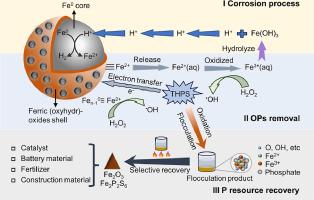快速高效地去除有机磷污染物并回收有价值的元素:消除废水中有机磷的强化战略
IF 11.4
1区 环境科学与生态学
Q1 ENGINEERING, ENVIRONMENTAL
引用次数: 0
摘要
考虑到有机磷化合物(OPs)的重大危害和磷(P)资源短缺的潜在危机,亟需开发经济可行、高效和可持续的策略来去除 OPs 并回收磷资源。本研究利用低成本的微尺度零价铁(mZVI)激活过氧化氢,快速高效地去除水生环境中的四羟甲基硫酸磷(THPS)。与传统的 Fenton 反应和商用 mZVI 相比,基于 mZVI/H2O2 的 Fenton 类反应对四羟甲基硫酸磷的去除性能更优。通过识别活性氧物种、表征分析和理论计算,深入阐明了 mZVI/H2O2 系统对 THPS 的去除机理。此外,通过对样品进行热诱导沉淀和高温煅烧,成功地回收了降解产物中的有价值成分。mZVI/H2O2 系统在去除各类实际废水中的有机化合物和改善废水的生物降解性方面具有显著优势。这项研究为消除 OPs 污染和回收 P 资源提供了一种环保、高效的策略。它还为实际工业废水的修复提供了一种易于操作的方法。本文章由计算机程序翻译,如有差异,请以英文原文为准。

Rapid and efficient removal of organophosphorus pollutant and recovery of valuable elements: A boosted strategy for eliminating organophosphorus from wastewater
Considering the significant hazards of organophosphorus compounds (OPs) and the potential crisis of phosphorus (P) resource shortage, there is a great necessity to develop economically feasible, highly effective, and sustainable strategies to remove OPs and recover P resources. In this study, low-cost microscale zero-valent iron (mZVI) was used to activate hydrogen peroxide for the rapid and efficient elimination of Tetrakis(hydroxymethyl)phosphonium sulfate (THPS) from the aquatic environment. Compared to the conventional Fenton reaction and commercial mZVI, mZVI/H2O2-based Fenton-like reaction exhibited superior removal performance for THPS. The removal mechanism of the mZVI/H2O2 system for THPS was thoroughly elucidated through the identification of reactive oxygen species, characterization analysis, and theoretical calculation. Furthermore, the valuable components of the degradation products were successfully recovered through thermally induced precipitation of the sample followed by high-temperature calcination. The mZVI/H2O2 system has demonstrated significant advantages in removing organic compounds from various types of actual wastewater and improving the biodegradability of the wastewater. This study presented an environmentally friendly and highly efficient strategy to eliminate OPs pollution and recover P resources. It also provided an easy-to-operate method for remediating actual industrial wastewater.
求助全文
通过发布文献求助,成功后即可免费获取论文全文。
去求助
来源期刊

Water Research
环境科学-工程:环境
CiteScore
20.80
自引率
9.40%
发文量
1307
审稿时长
38 days
期刊介绍:
Water Research, along with its open access companion journal Water Research X, serves as a platform for publishing original research papers covering various aspects of the science and technology related to the anthropogenic water cycle, water quality, and its management worldwide. The audience targeted by the journal comprises biologists, chemical engineers, chemists, civil engineers, environmental engineers, limnologists, and microbiologists. The scope of the journal include:
•Treatment processes for water and wastewaters (municipal, agricultural, industrial, and on-site treatment), including resource recovery and residuals management;
•Urban hydrology including sewer systems, stormwater management, and green infrastructure;
•Drinking water treatment and distribution;
•Potable and non-potable water reuse;
•Sanitation, public health, and risk assessment;
•Anaerobic digestion, solid and hazardous waste management, including source characterization and the effects and control of leachates and gaseous emissions;
•Contaminants (chemical, microbial, anthropogenic particles such as nanoparticles or microplastics) and related water quality sensing, monitoring, fate, and assessment;
•Anthropogenic impacts on inland, tidal, coastal and urban waters, focusing on surface and ground waters, and point and non-point sources of pollution;
•Environmental restoration, linked to surface water, groundwater and groundwater remediation;
•Analysis of the interfaces between sediments and water, and between water and atmosphere, focusing specifically on anthropogenic impacts;
•Mathematical modelling, systems analysis, machine learning, and beneficial use of big data related to the anthropogenic water cycle;
•Socio-economic, policy, and regulations studies.
 求助内容:
求助内容: 应助结果提醒方式:
应助结果提醒方式:


